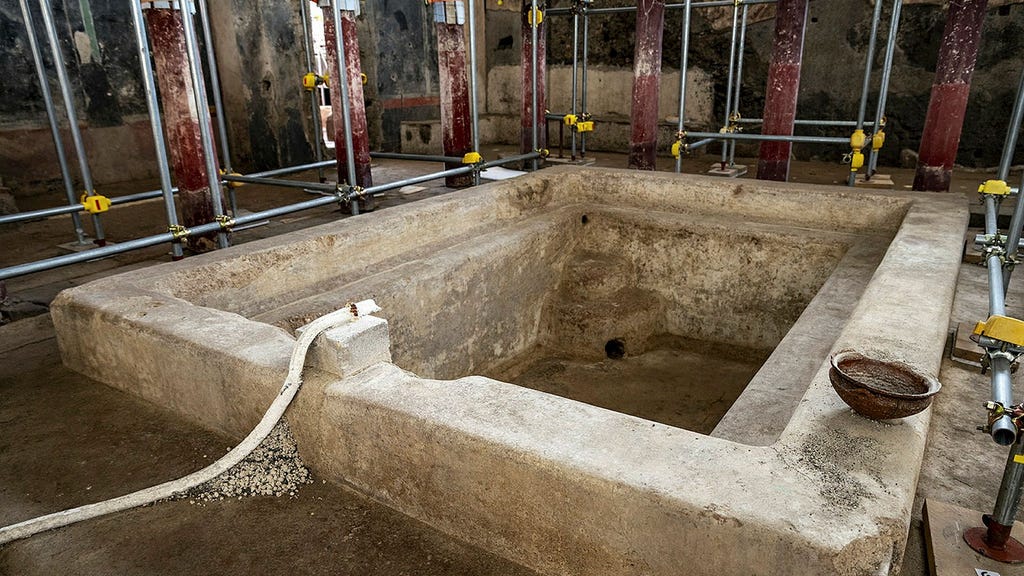A Glimpse into Opulence and Servitude: The Discovery of a Luxurious Bath Complex in Pompeii
The ancient Roman city of Pompeii, tragically buried by the eruption of Mount Vesuvius in 79 AD, continues to yield fascinating glimpses into the lives of its inhabitants. Recent excavations have unearthed a sprawling bath complex within a private residence, offering a stark contrast between the lavish lifestyles of the wealthy elite and the harsh realities faced by their enslaved counterparts. This remarkable discovery sheds light on the social dynamics of the era, showcasing the opulence enjoyed by the upper echelons of society while simultaneously highlighting the arduous conditions endured by those who served them.
The bath complex, estimated to accommodate up to 30 individuals, boasted a range of bathing options, including hot, lukewarm, and cold pools. This sophisticated setup, a rare find in private residences of the time, speaks volumes about the homeowner’s wealth and status. Archaeologists believe the residence likely belonged to a prominent figure, possibly a high-ranking politician, given the sheer scale and luxury of the bathing facility. Its grandeur surpasses other known private bath complexes in Pompeii, solidifying its status as a symbol of elite privilege.
Adjacent to the hot pool, a furnace room reveals the demanding labor required to maintain the complex’s operations. The intense heat generated by the furnaces paints a vivid picture of the grueling conditions endured by the slaves tasked with keeping the baths running. This stark juxtaposition of luxury and hardship underscores the vast social divide that characterized Roman society. The slaves’ tireless efforts ensured the comfort and pleasure of the wealthy, while they themselves toiled in sweltering conditions.
Adding another layer of intrigue to the discovery, two skeletons were found barricaded within a small room in the residence. One set of remains belonged to a woman between 35 and 50 years old, discovered alongside gold and silver jewelry and coins. This suggests she held a higher social standing, possibly the wife of the homeowner or a high-ranking attendant. The other skeleton belonged to a young man around 20, exhibiting signs of physical labor consistent with the life of a slave. The circumstances surrounding their deaths remain a mystery, adding to the enigma of Pompeii’s final moments.
This discovery adds to the growing body of knowledge about daily life in Pompeii, a city frozen in time by the catastrophic eruption of Mount Vesuvius. The elaborate bath complex, a testament to the luxurious lifestyle enjoyed by the city’s elite, stands in stark contrast to the harsh realities faced by the enslaved population. The discovery of the two skeletons provides a poignant reminder of the human tragedy that unfolded during the city’s final hours, further enriching our understanding of this ancient Roman city. With two-thirds of Pompeii still buried, ongoing excavations promise to reveal more captivating stories from the past, further illuminating the lives and destinies of those who called this ancient city home.
The ongoing excavations at Pompeii, with a third of the city still buried, continue to unveil remarkable insights into Roman life. The discovery of this luxurious bath complex, coupled with the poignant discovery of the two skeletons, paints a vivid picture of the social dynamics and daily realities of Pompeii’s inhabitants. It underscores the vast disparity between the privileged elite and their enslaved counterparts, offering a glimpse into the opulence and hardship that coexisted within the city’s walls. The meticulous archaeological work being carried out promises to reveal further captivating stories, providing an even richer understanding of Pompeii’s vibrant past and the dramatic events that led to its sudden demise.














